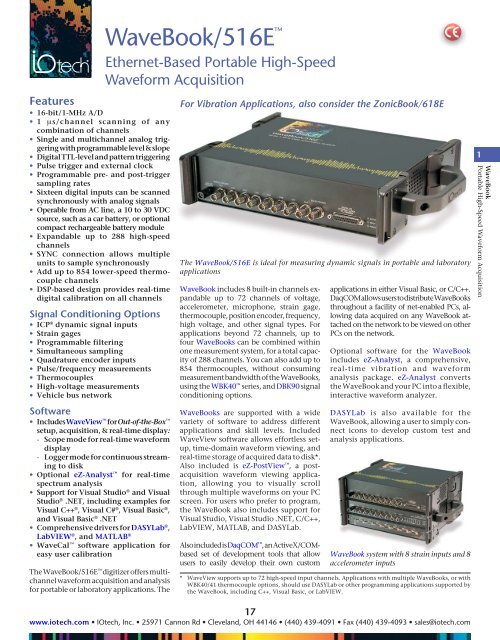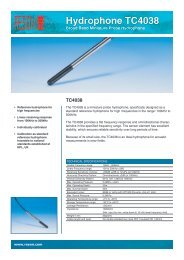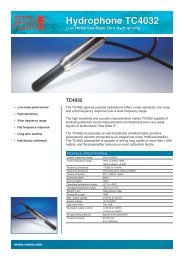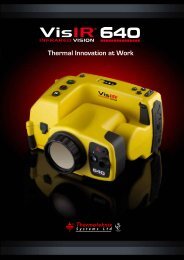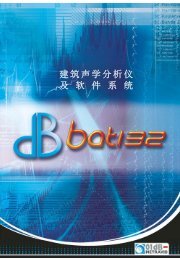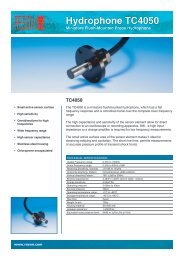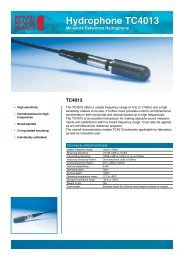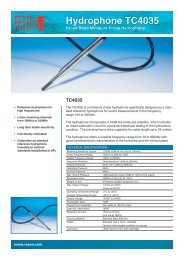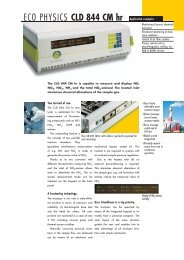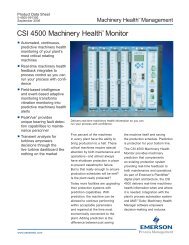Ethernet-Based Portable High-Speed Waveform Acquisition
Ethernet-Based Portable High-Speed Waveform Acquisition
Ethernet-Based Portable High-Speed Waveform Acquisition
You also want an ePaper? Increase the reach of your titles
YUMPU automatically turns print PDFs into web optimized ePapers that Google loves.
WaveBook<br />
<strong>Portable</strong> <strong>High</strong>-<strong>Speed</strong> <strong>Waveform</strong> <strong>Acquisition</strong><br />
®<br />
Features<br />
• 16-bit/1-MHz A/D<br />
• 1 µs/channel scanning of any<br />
combination of channels<br />
• Single and multichannel analog triggering<br />
with programmable level & slope<br />
• Digital TTL-level and pattern triggering<br />
• Pulse trigger and external clock<br />
• Programmable pre- and post-trigger<br />
sampling rates<br />
• Sixteen digital inputs can be scanned<br />
synchronously with analog signals<br />
• Operable from AC line, a 10 to 30 VDC<br />
source, such as a car battery, or optional<br />
compact rechargeable battery module<br />
• Expandable up to 288 high-speed<br />
channels<br />
• SYNC connection allows multiple<br />
units to sample synchronously<br />
• Add up to 854 lower-speed thermocouple<br />
channels<br />
• DSP-based design provides real-time<br />
digital calibration on all channels<br />
Signal Conditioning Options<br />
• ICP ® dynamic signal inputs<br />
• Strain gages<br />
• Programmable filtering<br />
• Simultaneous sampling<br />
• Quadrature encoder inputs<br />
• Pulse/frequency measurements<br />
• Thermocouples<br />
• <strong>High</strong>-voltage measurements<br />
• Vehicle bus network<br />
Software<br />
• Includes WaveView for Out-of-the-Box <br />
setup, acquisition, & real-time display:<br />
- Scope mode for real-time waveform<br />
display<br />
- Logger mode for continuous streaming<br />
to disk<br />
• Optional eZ-Analyst for real-time<br />
spectrum analysis<br />
• Support for Visual Studio ® and Visual<br />
Studio ® .NET, including examples for<br />
Visual C++ ® , Visual C# ® , Visual Basic ® ,<br />
and Visual Basic ® .NET<br />
• Comprehensive drivers for DASYLab ® ,<br />
LabVIEW ® , and MATLAB ®<br />
• WaveCal software application for<br />
easy user calibration<br />
The WaveBook/516E digitizer offers multichannel<br />
waveform acquisition and analysis<br />
for portable or laboratory applications. The<br />
WaveBook/516E <br />
<strong>Ethernet</strong>-<strong>Based</strong> <strong>Portable</strong> <strong>High</strong>-<strong>Speed</strong><br />
<strong>Waveform</strong> <strong>Acquisition</strong><br />
For Vibration Applications, also consider the ZonicBook/618E<br />
The WaveBook/516E is ideal for measuring dynamic signals in portable and laboratory<br />
applications<br />
WaveBook includes 8 built-in channels expandable<br />
up to 72 channels of voltage,<br />
accelerometer, microphone, strain gage,<br />
thermocouple, position encoder, frequency,<br />
high voltage, and other signal types. For<br />
applications beyond 72 channels, up to<br />
four WaveBooks can be combined within<br />
one measurement system, for a total capacity<br />
of 288 channels. You can also add up to<br />
854 thermocouples, without consuming<br />
measurement bandwidth of the WaveBooks,<br />
using the WBK40 series, and DBK90 signal<br />
conditioning options.<br />
WaveBooks are supported with a wide<br />
variety of software to address different<br />
applications and skill levels. Included<br />
WaveView software allows effortless setup,<br />
time-domain waveform viewing, and<br />
real-time storage of acquired data to disk*.<br />
Also included is eZ-PostView , a postacquisition<br />
waveform viewing application,<br />
allowing you to visually scroll<br />
through multiple waveforms on your PC<br />
screen. For users who prefer to program,<br />
the WaveBook also includes support for<br />
Visual Studio, Visual Studio .NET, C/C++,<br />
LabVIEW, MATLAB, and DASYLab.<br />
Also included is DaqCOM , an ActiveX/COMbased<br />
set of development tools that allow<br />
users to easily develop their own custom<br />
applications in either Visual Basic, or C/C++.<br />
DaqCOM allows users to distribute WaveBooks<br />
throughout a facility of net-enabled PCs, allowing<br />
data acquired on any WaveBook attached<br />
on the network to be viewed on other<br />
PCs on the network.<br />
Optional software for the WaveBook<br />
includes eZ-Analyst, a comprehensive,<br />
real-time vibration and waveform<br />
analysis package. eZ-Analyst converts<br />
the WaveBook and your PC into a flexible,<br />
interactive waveform analyzer.<br />
DASYLab is also available for the<br />
WaveBook, allowing a user to simply connect<br />
icons to develop custom test and<br />
analysis applications.<br />
WaveBook system with 8 strain inputs and 8<br />
accelerometer inputs<br />
* WaveView supports up to 72 high-speed input channels. Applications with multiple WaveBooks, or with<br />
WBK40/41 thermocouple options, should use DASYLab or other programming applications supported by<br />
the WaveBook, including C++, Visual Basic, or LabVIEW.<br />
1<br />
17<br />
www.iotech.com • IOtech, Inc. • 25971 Cannon Rd • Cleveland, OH 44146 • (440) 439-4091 • Fax (440) 439-4093 • sales@iotech.com
®<br />
WaveBook/516E <br />
General Information<br />
A family of 8-channel WBK expansion<br />
options provide volts, accelerometer,<br />
strain gage, frequency, and quadrature<br />
encoder measurements. Other WBK options<br />
provide isolated inputs as well as<br />
temperature measurement capability.<br />
Most WBK options are fully programmable<br />
for gain/range, filter cut-off<br />
frequency, AC/DC coupling, etc.<br />
The WaveBook’s design is optimized for expansion,<br />
reconfiguration and portability. There<br />
are no bulky expansion chassis that must be<br />
purchased in anticipation of future applications.<br />
The compact, all-metal chassis features<br />
a low-profile package with front panel inputs.<br />
The WaveBook provides sophisticated<br />
multichannel triggering, usually associated<br />
with larger, more expensive waveform<br />
recorders. The DSP-based design also<br />
makes the system more compact than<br />
others of similar performance.<br />
The WaveBook operates on a wide range of<br />
power sources, such as a standard AC line,<br />
an optional rechargeable battery supply, or<br />
even a 12V car battery.<br />
All WaveBooks feature an input buffer<br />
amplifier on each of its eight channels.<br />
This architecture isolates the input signals<br />
from any multiplexing transients and<br />
greatly improves frequency response. It<br />
also provides far less sensitivity to inputsignal<br />
source impedance.<br />
To achieve superior signal fidelity, excellent<br />
noise immunity, and greater accuracy,<br />
the WaveBook follows the input<br />
buffer amplifier with individual differential<br />
and programmable gain amplifiers<br />
on each channel. In addition, a 5-pole,<br />
20-kHz Butterworth anti-aliasing filter<br />
can be software-enabled on a per channel<br />
basis to protect against aliasing of highfrequency<br />
signal components. For additional<br />
gain and filtering, the WaveBook<br />
can be factory configured with a<br />
WBK11A , WBK12A , or WBK13A .<br />
The WaveBook’s DSP automatically compensates<br />
for offset and gain errors in each of<br />
its amplifiers, including those found in the<br />
WBK expansion options on a per-reading,<br />
real-time basis. This compensation is based<br />
on calibration constants calculated during<br />
Eight<br />
differential<br />
analog<br />
inputs<br />
8<br />
7<br />
6<br />
5<br />
4<br />
3<br />
2<br />
1<br />
Expansion<br />
unit control<br />
BNC Inputs<br />
16<br />
high-speed<br />
digital<br />
inputs<br />
Expansion<br />
signal input<br />
(from optional<br />
WBK10A, WBK14,<br />
WBK15, WBK16,<br />
WBK17, or WBK18)<br />
Buffers<br />
HD-15S<br />
connector<br />
Differential<br />
amplifier<br />
Wide band<br />
amplifier<br />
Pulse<br />
input<br />
75Ω<br />
BNC<br />
input<br />
Differential<br />
amplifier<br />
the system’s calibration process. The constants<br />
are stored in the system’s nonvolatile<br />
memory. The DSP also permits the<br />
WaveBook to accept user-supplied calibration<br />
constants, enabling it to automatically<br />
scale the input signal for gain and offset<br />
individually on every channel.<br />
The WaveBook offers both bipolar and unipolar<br />
input ranges, which are per-channel<br />
16<br />
Buffers<br />
Fixed 5-pole<br />
anti-alias filter<br />
Pulse<br />
discriminator<br />
and analog<br />
trigger<br />
DAC<br />
TTL trigger<br />
input<br />
* Expandable with WBK30 option up to 128 Mbytes<br />
WaveBook/516E Block Diagram<br />
PGA<br />
x1, 2, 5, 10<br />
Ext.<br />
clock and<br />
frequency<br />
counter<br />
+5<br />
–5<br />
+15<br />
–15<br />
1-MHz, 16-bit<br />
A/D converter<br />
circuitry<br />
Digital signal<br />
processor<br />
(DSP)<br />
Scan<br />
sequence<br />
table<br />
Real-time<br />
digital<br />
correction<br />
65536 *<br />
FIFO data<br />
buffer<br />
Power supply<br />
16<br />
DC/DC<br />
converter<br />
Expansion<br />
input select<br />
100 MHz<br />
time<br />
base<br />
Trigger<br />
select<br />
Power<br />
input<br />
Communications<br />
processor<br />
Power from included<br />
AC adapter, optional<br />
rechargeable battery<br />
module, 12V car<br />
battery, or any 10 to<br />
30 VDC source<br />
Unipolar/<br />
bipolar<br />
level shifter<br />
EEPROM<br />
Control<br />
&<br />
timing<br />
<strong>High</strong>speed<br />
EPP<br />
interface<br />
10/100BaseT<br />
<strong>Ethernet</strong><br />
Expansion port 1 Expansion port 2 Expansion port 3<br />
External<br />
SYNC<br />
To additional WaveBook/512A, WaveBook/516A, or WBK40 series options<br />
programmable via the sequencer. Bipolar<br />
ranges can extend from ±0.05V to ±10V.<br />
Unipolar ranges can span from 100 mV<br />
to 10V.<br />
The WaveBook also features a 16-bit highspeed<br />
TTL digital I/O port for recording<br />
discrete TTL-level signals at the beginning<br />
of each scan, providing time<br />
correlation with the analog inputs.<br />
18<br />
www.iotech.com • IOtech, Inc. • 25971 Cannon Rd • Cleveland, OH 44146 • (440) 439-4091 • Fax (440) 439-4093 • sales@iotech.com
WaveBook<br />
<strong>Portable</strong> <strong>High</strong>-<strong>Speed</strong> <strong>Waveform</strong> <strong>Acquisition</strong><br />
®<br />
WaveBook/516E <br />
Triggering<br />
Triggering<br />
The WaveBook offers a variety of trigger<br />
modes. Selection of the optimal trigger<br />
mode for your particular application<br />
requirements saves time and disk space<br />
by ensuring that you capture only the<br />
data of interest.<br />
A wide selection of programmable analog<br />
and digital trigger modes are available for<br />
starting an acquisition. All trigger modes,<br />
along with the number of scans and the<br />
sample rate for pre- and post-trigger data,<br />
are software programmable prior to the<br />
start of a scan sequence. The WaveBook also<br />
supports digital pattern and pulse triggering.<br />
Trigger latency (the maximum time<br />
from the trigger to the first reading of a scan<br />
group) and jitter (the variation of the latency<br />
from acquisition to acquisition) depend<br />
on the specific trigger source and type<br />
of acquisition. Descriptions of each trigger<br />
source and the various trigger modes follow.<br />
Software Trigger. A software trigger is<br />
issued by the PC, and causes the WaveBook<br />
to begin scanning the setup predefined in<br />
the scan buffer. The trigger latency in<br />
this mode is longer than in other trigger<br />
modes and is a direct function of the<br />
PC’s performance. It is typically 100 µs<br />
or less in post-trigger acquisitions.<br />
Digital TTL Trigger. The WaveBook accepts<br />
a single TTL-level signal input to<br />
the DB25 digital I/O connector with<br />
rising- or falling-edge trigger sensitivity<br />
selected through software. Trigger latency<br />
in this mode is less than 300 ns for<br />
post-trigger acquisitions.<br />
Digital Pattern Trigger. In addition to<br />
digital trigger, the WaveBook supports<br />
digital pattern triggering. This allows<br />
data collection to start when a userdefined<br />
16-bit digital pattern is matched<br />
on the digital I/O connector. For example,<br />
it is useful when trying to capture<br />
noise, vibrations, or some other<br />
physical disturbance which occurs at a<br />
particular point in a digitally sequenced<br />
process, from a PLC or relay logic control<br />
system. Trigger latency of the digital<br />
pattern trigger is less than 300 ns for<br />
post-trigger acquisitions.<br />
Pulse Trigger. This high bandwidth input<br />
enables the triggering and the correlation<br />
of lower speed waveforms with the<br />
occurence of a high speed pulse. With<br />
Pulse Trigger, the user defines a pulse by<br />
an amplitude between ±5V and a pulse<br />
width from 300 ns to 0.8 sec.<br />
Analog Trigger Source. Analog sources are<br />
the most commonly used triggers. The<br />
WaveBook supports both single-channel<br />
analog triggers for quick captures, as well as<br />
multichannel analog triggering.<br />
Single-Channel Analog Trigger. Simple<br />
single-channel trigger performs analog comparison<br />
of channel one to a programmable<br />
12-bit DAC value. You can also select risingor<br />
falling-edge criteria. Trigger latency is<br />
less than 500 ns.<br />
When a WBK11A, WBK12A, or WBK13A<br />
option is installed (providing simultaneous<br />
sample and hold or filtering), the trigger<br />
input signal is amplified by the simultaneous<br />
sample and hold amplifier before<br />
being compared against the analog trigger<br />
level. This can increase the trigger signal’s<br />
sensitivity by a factor of 100.<br />
Multichannel Analog Trigger. Multichannel<br />
triggering eliminates spurious data by<br />
letting you enter a more selective trigger<br />
condition to capture events of specific<br />
interest. In multichannel mode, any combination<br />
of up to 72 analog channels can<br />
contribute to the trigger condition. You<br />
can individually program each channel<br />
to satisfy its trigger criteria using one of<br />
eight states from a combination of above/<br />
below level, rising/falling edge, and instantaneous/latched<br />
duration. In addition,<br />
you can also define a hysteresis band<br />
for each channel, reducing false triggers<br />
when used with auto re-arm. Finally, you<br />
can join all trigger channels together using<br />
“ANY” (logical “OR” condition) or “ALL”<br />
(logical “AND” condition) Boolean logic<br />
operands to form a single, unified trigger<br />
condition.<br />
The maximum latency possible in posttrigger<br />
acquisitions of the multichannel<br />
trigger mode is 2 µs per designated trigger<br />
channel, plus 4 µs. For example, if five<br />
trigger channels are designated, the maximum<br />
latency is 14 µs. The minimum<br />
latency in this mode is half the maximum<br />
rate; thus, the multichannel trigger jitter<br />
time is 1 µs per trigger channel, plus 2 µs.<br />
<strong>Acquisition</strong> Modes<br />
The WaveBook lets you select one of several<br />
acquisition modes for collecting your<br />
pre- and post-trigger data. The system<br />
offers four post-trigger modes and two<br />
pre-trigger modes. The WaveBook uses a<br />
combination of internal memory, PC<br />
RAM, and your PC’s hard disk to seamlessly<br />
record all acquired data during the<br />
acquisition process.<br />
Post-Trigger <strong>Acquisition</strong><br />
In post-trigger acquisition, the WaveBook<br />
acquires data only after a trigger condition<br />
has been met. You have a choice of<br />
four post-trigger acquisition modes, each<br />
offering benefits suited to particular<br />
applications.<br />
Infinite Linear Mode. In infinite linear<br />
mode, the system acquires data for an<br />
infinite amount of time after a trigger<br />
occurs. This mode is most useful for chartrecorder<br />
replacement applications that<br />
require long recordings. Once started, the<br />
system keeps digitizing until a “stop” command<br />
is issued by your PC. The amount of<br />
data you can acquire depends on your<br />
PC‘s available memory resources.<br />
Infinite Circular Mode. In infinite circular<br />
mode, the system acquires data into a circular<br />
buffer indefinitely until it receives a<br />
“stop” command from the PC. When the<br />
circular buffer is full, it overwrites previously<br />
1<br />
19<br />
www.iotech.com • IOtech, Inc. • 25971 Cannon Rd • Cleveland, OH 44146 • (440) 439-4091 • Fax (440) 439-4093 • sales@iotech.com
®<br />
WaveBook/516E <br />
Triggering<br />
acquired data; thus the buffer always contains<br />
the most recently acquired data. This<br />
mode is most useful for applications in<br />
which file size is limited by PC resources, or<br />
an indeterminate number of scans will occur<br />
before the stop condition occurs and only<br />
the last scans are required. A typical application<br />
is destructive testing in which acquisition<br />
is complete when the device fails, and<br />
only the final failure mode characteristics<br />
need to be captured.<br />
Finite Linear Mode. When operating in<br />
finite linear mode, the system acquires data<br />
after receipt of the trigger until a specified<br />
number of scans (from 1 to 100 million) are<br />
acquired. Finite linear mode is suitable for<br />
applications in which the duration of the<br />
event is known.<br />
Re-arm. Finite linear mode permits the<br />
specification of the “re-arm” condition.<br />
Under such a condition, after a specified<br />
number of scans is acquired, the system<br />
automatically prepares for a new<br />
acquisition by re-arming and re-enabling<br />
the trigger, and then capturing a new<br />
finite number of scans without the need<br />
for either user or computer intervention.<br />
This capability is useful in emulating a<br />
DSO (Digital Storage Oscilloscope), which<br />
typically offers continuous retrace. It is<br />
also beneficial for unattended captures in<br />
which critical trigger events occur at<br />
indeterminate intervals, making manual<br />
re-arms awkward. It is further useful for<br />
applications in which trigger events occur<br />
so quickly that it is difficult to respond<br />
manually or under software control.<br />
Finite Circular Mode. In this mode, the<br />
WaveBook acquires data into a circular buffer<br />
until a specified number of scans (from 1 to<br />
100 million) is acquired. When the circular<br />
buffer becomes full, it writes over previously<br />
acquired data, and thus always contains<br />
the most recently acquired data. This<br />
mode is useful for trigger delays; for example,<br />
the unit can be pre-configured to<br />
record 100,000 scans (after the trigger) at 10<br />
µs intervals and to save only the last 10,000<br />
of the 100,000. In this example, the final<br />
record would contain only data acquired<br />
900 ms after the trigger.<br />
Channel-Scanning Flexibility<br />
The WaveBook provides maximum<br />
scanning flexibility via a programmable<br />
channel/range sequencer. You can load<br />
the sequencer with any combination of<br />
channels and associated ranges. Once<br />
loaded, the sequencer waits for the trigger<br />
condition to be satisfied, after which<br />
it begins scanning and digitizing. When<br />
scanning begins, the WaveBook selects<br />
the appropriate channel and gain, digitizes<br />
the input signal, calibrates the<br />
reading, and transmits it to the PC via<br />
the on-board, 65 Kword FIFO buffer (or<br />
into optional internal memory, up to<br />
128 Mbytes). This process is repeated at<br />
a 1 µs/sample rate until all channels<br />
within a scan group are completed.<br />
period of 1 µs to 100s, programmable in<br />
0.05 µs increments. It can also be programmed<br />
to wait indefinitely until the<br />
trigger condition is next satisfied, after<br />
which it will again perform a specified<br />
number of scans, from 1 to 100 million.<br />
The WaveBook also supports pretriggering,<br />
and is capable of acquiring<br />
up to 100 million scans prior to satisfaction<br />
of the trigger condition. The<br />
pre-trigger buffer is circular, and thus<br />
always provides the most recently acquired<br />
readings prior to the occurrence<br />
of the trigger. In addition, the<br />
system permits pre-trigger scan group<br />
repetition at one rate and post-trigger<br />
scan group repetition at another rate.<br />
Upon completion of a scan group, the For example, the system can be configured<br />
to repeat scans 1,000 times<br />
WaveBook can be configured to proceed<br />
in one of several fashions. For per second prior to the trigger, and<br />
example, the system can be programmed<br />
to begin the next scan after a receipt of the<br />
then 100,000 times per second after<br />
trigger.<br />
Scan group<br />
Programmable<br />
from either an<br />
internal or an<br />
Digital input lines, external clock<br />
tach inputs, and<br />
encoders can also be<br />
sampled before the<br />
analog inputs in a<br />
sequence 1 µs<br />
WaveBook Scanning Example<br />
All channels within a scan group are<br />
measured at a fixed 1 µs/channel<br />
t<br />
Channel D #2 #4 #7 #2 #18 #9 #16<br />
Gain<br />
x1 x10 x5 x10 x10 x5 x1<br />
Unipolar or<br />
Uni Bi Uni Uni Bi Bi Uni<br />
bipolar<br />
Unipolar or bipolar operation can be<br />
Expansion channels<br />
programmed for each channel dynamically<br />
are sampled at the<br />
Gain can be programmed for<br />
same rate as<br />
each channel dynamically<br />
internal channels<br />
Channels can be<br />
sampled arbitrarily<br />
t<br />
20<br />
www.iotech.com • IOtech, Inc. • 25971 Cannon Rd • Cleveland, OH 44146 • (440) 439-4091 • Fax (440) 439-4093 • sales@iotech.com
WaveBook<br />
<strong>Portable</strong> <strong>High</strong>-<strong>Speed</strong> <strong>Waveform</strong> <strong>Acquisition</strong><br />
®<br />
WaveBook/516E <br />
Triggering<br />
Pre-Trigger <strong>Acquisition</strong><br />
Pre-trigger permits the acquisition of readings<br />
prior to the receipt of a trigger condition.<br />
Pre-trigger can be used with any of the<br />
four trigger modes described above.<br />
When pre-trigger is selected, the rate at<br />
which a scan group repeats can differ before<br />
and after a trigger*. (Please note while the<br />
sample rates between pre- and post-trigger<br />
scan groups can differ, the time between<br />
consecutive samples within a group is fixed<br />
at 1 µs). For example, a scan group of 8<br />
channels can be repeated at 1000 scans per<br />
second prior to a trigger condition, and at<br />
100,000 scans per second after the trigger.<br />
The number of scans acquired during both<br />
time periods is also programmable.<br />
The WaveBook first acquires a specified<br />
number of pre-trigger scans at the pretrigger<br />
scan rate, and then arms the trigger,<br />
guaranteeing that at least the specified<br />
number of scans have been acquired<br />
before the trigger. The system continues<br />
to collect scans at the pre-trigger scan rate<br />
until the trigger occurs. Once the trigger<br />
is detected, the system finishes collecting<br />
the current pre-trigger scan, switches to<br />
the post-trigger scan rate, acquires readings<br />
using one of the four post-trigger modes<br />
described above, and then stops the acquisition.<br />
The number of pre-trigger and posttrigger<br />
scans are each independently<br />
programmable from 1 to 100 million.<br />
Pre-Trigger Circular Mode (requires WBK30<br />
installed). In this mode, data is placed into<br />
a circular buffer until the buffer fills, after<br />
which the buffer writes over previously<br />
acquired data. The system stays in this<br />
mode, waiting for the pre-set trigger condition<br />
to be met, until the condition occurs or<br />
the acquisition is halted by the PC. Upon<br />
detection of the trigger condition, the system<br />
begins the post-acquisition readings. Since,<br />
for practical applications, the WaveBook is<br />
only limited by the PC’s resources, extremely<br />
deep circular buffers can be configured for<br />
both the pre- and post-trigger data.<br />
Pre-Trigger Linear Mode**. In this mode,<br />
the WaveBook continues collecting data<br />
without writing over old data. Since the<br />
amount of pre-trigger data can be nearly<br />
infinite (if the trigger takes a very long time<br />
to occur), this mode may require extensive<br />
PC resources to avoid data loss. Unlike the<br />
pre-trigger circular mode, which delays the<br />
trigger arm condition until a predefined<br />
number of scans is collected, the pre-trigger<br />
linear mode permits the WaveBook to begin<br />
recording post-trigger data as soon as the<br />
trigger condition is met, regardless of the<br />
number of pre-trigger scans collected. This<br />
mode is useful for applications in which the<br />
desired number of pre-trigger scans is indeterminate<br />
prior to the start of acquisition<br />
and all data must be acquired.<br />
External Clock Input<br />
The WaveBook supports an external clock<br />
input, allowing the scanning of data to be<br />
dependent upon an external pulse train.<br />
This feature is useful in rotating machine or<br />
motion applications where data collection<br />
is dependent upon rotational speed or axial<br />
position. In addition to allowing one scan<br />
per pulse, the WaveBook’s external clock<br />
input features a programmable divider<br />
capable of reducing the incoming clock by<br />
up to 255. This is useful when the external<br />
clock source is faster than the optimum<br />
sample rate for the data collection task.<br />
External Clock Timer † . The WaveBook features<br />
an internal timer capable of reporting<br />
the period of the external clock input. This<br />
value can be read with each scan †† of the<br />
analog data and is reset by the rising edge of<br />
the incoming clock. This is often beneficial<br />
in later analysis where physical phenomena<br />
needs to be correlated to speed.<br />
Multi-Unit Synchronization<br />
Multiple WaveBook/516As, WaveBook/512As,<br />
WaveBook/516Es, and WBK40/41s can be<br />
synchronized via the rear-panel SYNC<br />
ports. Simply connect 2, 3, or 4 WaveBooks<br />
together using SYNC cables (CA-74-1).<br />
WaveBook software establishes one of the<br />
WaveBooks as the “master” and the others<br />
as “slaves”. Master WaveBooks can run at<br />
the full 1-MHz aggregate sampling rate;<br />
slave WaveBooks must have 0.1 µs of unassigned<br />
sampling time in the scan group<br />
(some trigger modes are not supported in<br />
multi-WaveBook systems).<br />
Simultaneous Sampling †††<br />
The WaveBook samples each channel in<br />
sequence, at a fixed 1 µs/channel rate. For<br />
example, when eight channels are scanned<br />
sequentially, the time between sampling<br />
the first channel and the eighth channel<br />
is 7 µs. For applications that require simultaneous<br />
sampling (within 100 ns) of<br />
all channels, the optional WBK11A eightchannel<br />
simultaneous sample and hold<br />
card and the WBK13A programmable lowpass<br />
filter card with simultaneous sample<br />
and hold are available. The WBK11A or<br />
WBK13A can be installed in the<br />
WaveBook, or the WBK10A expansion<br />
chassis; they provide simultaneous sampling<br />
of all channels in a module. Even<br />
when multiple WBK11A or WBK13A cards<br />
are used within one system, all channels<br />
with simultaneous sample and hold active<br />
are sampled within 100 ns of one<br />
another. Some WBK options include builtin<br />
simultaneous sampling, including the<br />
WBK16/SSH , and WBK18 .<br />
1<br />
* eZ-PostView software does not support pre-trigger scan rates that differ from post<br />
** Pre-trigger linear mode and auto re-arm in the WaveBook hardware are not supported in WaveView<br />
† External clock counter and the high-speed digital inputs are mutually exclusive; adding the external clock<br />
counter to the scan list is equivalent to adding two analog channels<br />
†† Requires two locations in the scan sequencer<br />
††† The maximum scan rate when using SS&H is<br />
1 MHz<br />
where n=number of channels in the scan list<br />
(n + 1)<br />
21<br />
www.iotech.com • IOtech, Inc. • 25971 Cannon Rd • Cleveland, OH 44146 • (440) 439-4091 • Fax (440) 439-4093 • sales@iotech.com
®<br />
WaveBook/516E <br />
System Power Connection<br />
The WaveBook and its associated WBK<br />
modules offer the flexibility to be powered<br />
either directly from a 10V to 30V DC<br />
source or via the included TR-40U AC<br />
power adapter. Options such as the<br />
WBK11A, WBK12A, and WBK13A signal<br />
conditioning cards install directly into<br />
the WaveBook or WBK10A and derive<br />
their power from those units.<br />
Table 1<br />
If you are operating each module with its<br />
included TR-40U AC power adapters, then<br />
no calculations are required; just connect<br />
the power adapters. In certain applications,<br />
however, it may be advantageous or more<br />
convenient to operate all components from<br />
a single source such as a battery or UPS such<br />
as the DBK34A . In those cases, the following<br />
worktables provide the necessary information<br />
for calculating current requirements<br />
for your particular system.<br />
module has a pass-through connector<br />
allowing a number of modules to be<br />
daisy chained, up to the 5-ampere limit<br />
of the connector and CA-115 power expansion<br />
cable. The exact number of daisy<br />
chained modules is dependent upon<br />
your exact configuration.<br />
WaveBook System<br />
Power Example<br />
DBK30A<br />
DBK34A<br />
TR-40U<br />
Input Maximum Output<br />
The table below shows the current draw<br />
To included TR-40U<br />
1.9 Amps<br />
available from IOtech’s DBK30A <br />
5.0 Amps<br />
rechargeable battery module, the DBK34A <br />
3.3 Amps<br />
DC UPS, and the included TR-40U AC<br />
POWER<br />
WaveBook system<br />
power adapter. To minimize cabling, each<br />
Calculating the Current<br />
Table 2 provides the approximate required amperage for each component in your system<br />
when using a 15V supply. Using this table, calculate the maximum amount of amperage<br />
your system will draw by multiplying the quantity of components used by the amperage.<br />
Total the values in the last column to arrive at the maximum amperage; then verify that<br />
your power source has enough current capacity (see Table 1).<br />
Table 2: Wavebook & Option Current Usage<br />
Units Qty. Amps Total<br />
WaveBook/516E x 2.10 =<br />
WaveBook/512A and WaveBook/516A x 1.40 =<br />
WBK10A, 8-channel expansion module x 0.30 =<br />
WBK11A, 8-channel simultaneous sample & hold card x 0.45 =<br />
WBK12A, 8-channel programmable low-pass filter card x 0.45 =<br />
WBK13A, 8-channel programmable low-pass filter card with SS&H x 0.50 =<br />
WBK14, 8-channel dynamic signal conditioning module x 0.85 =<br />
WBK15, 8-channel 5B signal conditioning module x 0.10 =<br />
WBK15, with 8 5B strain modules (max load) x 0.75 =<br />
WBK16, 8-channel strain gage module (no load) x 1.00 =<br />
WBK16/SSH, 8-channel simultaneous sample & hold module x 1.20 =<br />
WBK17, 8-channel counter/encoder module x 0.52 =<br />
WBK18, 8-channel dynamic signal conditioning module x 1.20 =<br />
WBK30, memory option for the WaveBook x 0.01 =<br />
WBK40 series, modules for WaveBook/516E, with no expansion x 0.60 =<br />
WBK40 series, modules for WaveBook/516E, with five DBK84’s x 1.30 =<br />
DBK65, 8-channel transducer interface module x 0.83 =<br />
DBK70, vehichle network interface* x 0.50 =<br />
Max. Amps:<br />
0 1 POWER IN POWER OUT<br />
MADE IN USA (+10VDC TO +30VDC)<br />
POWER<br />
0 1 POWER IN POWER OUT<br />
( C O C)<br />
AC power adapter,<br />
DBK30A, or DBK34A<br />
CA-115 cable<br />
WBK10A expansion<br />
module<br />
Typical single-source,<br />
two-module power connection<br />
* Typically draws power from diagnostic connector<br />
22<br />
www.iotech.com • IOtech, Inc. • 25971 Cannon Rd • Cleveland, OH 44146 • (440) 439-4091 • Fax (440) 439-4093 • sales@iotech.com
MADE IN USA<br />
START CHARGE<br />
0 1 POWER IN POWER OUT<br />
(+18 VDC TO +22 VDC) (TO DAQBOOK)<br />
DBK30A BATTERY MODULE<br />
POWER IN POWER OUT<br />
BATTERY<br />
CHARGING<br />
WaveBook<br />
<strong>Portable</strong> <strong>High</strong>-<strong>Speed</strong> <strong>Waveform</strong> <strong>Acquisition</strong><br />
®<br />
WaveBook/516E <br />
External Power Modules<br />
DBK30A <br />
For small, portable applications, the optional DBK30A rechargeable<br />
battery module provides up to 3.5 hours of operation<br />
at 2.0A current draw. The DBK30A, which is housed in a rugged<br />
metal enclosure of the same footprint as the WaveBook, and can<br />
be mounted under the system by using the built-in mounting<br />
brackets. The DBK30A includes an AC charging supply.<br />
Notebook PC<br />
WaveBook<br />
1<br />
DBK30A<br />
The DBK30A rechargeable battery/excitation module<br />
enables autonomous operation of the WaveBook<br />
The DBK30A rechargeable battery/excitation module<br />
DBK34A <br />
The DBK34A provides back-up power as an uninterruptible<br />
power supply (UPS) to the WaveBook. If DC power is interrupted<br />
during an acquisition, this module provides temporary<br />
power so the measurement is not disturbed. The DBK34A<br />
is powered from an external DC power supply; it does not<br />
include an AC charger.<br />
Notebook PC<br />
WaveBook<br />
DBK34A<br />
To vehicle DC power<br />
If the WaveBook’s primary DC power source is interrupted, the<br />
DBK34A UPS module can serve as a backup power supply so that<br />
acquisition can continue uninterrupted<br />
The DBK34A rechargeable lead-acid battery/UPS (uninterruptible<br />
power supply) module<br />
The CA-116 optional cigarette-lighter power adapter provides DC<br />
power to the WaveBook in automotive applications<br />
23<br />
www.iotech.com • IOtech, Inc. • 25971 Cannon Rd • Cleveland, OH 44146 • (440) 439-4091 • Fax (440) 439-4093 • sales@iotech.com
ANALOG TRIGGER<br />
ANALOG CH1 CH2<br />
COMMON<br />
MADE IN U.S.A.<br />
CH3<br />
CH4<br />
CH5<br />
CH6<br />
CH7<br />
CH8 PULSE TRIGGER<br />
DIGITAL I/O<br />
EXTERNAL CLOCK<br />
TTL TRIGGER<br />
ACTIVE<br />
READY<br />
POWER<br />
ANALOG TRIGGER<br />
ANALOG CH1 CH2<br />
COMMON<br />
MADE IN U.S.A.<br />
ANALOG TRIGGER<br />
ANALOG CH1 CH2<br />
COMMON<br />
MADE IN U.S.A.<br />
ANALOG TRIGGER<br />
ANALOG CH1 CH2<br />
COMMON<br />
MADE IN U.S.A.<br />
CH3<br />
CH3<br />
CH3<br />
CH4<br />
CH4<br />
CH4<br />
CH5<br />
CH5<br />
CH5<br />
CH6<br />
CH6<br />
CH6<br />
CH7<br />
CH7<br />
CH7<br />
CH8 PULSE TRIGGER<br />
CH8 PULSE TRIGGER<br />
CH8 PULSE TRIGGER<br />
DIGITAL I/O<br />
EXTERNAL CLOCK<br />
TTL TRIGGER<br />
DIGITAL I/O<br />
EXTERNAL CLOCK<br />
TTL TRIGGER<br />
DIGITAL I/O<br />
EXTERNAL CLOCK<br />
TTL TRIGGER<br />
ACTIVE<br />
READY<br />
POWER<br />
ACTIVE<br />
READY<br />
POWER<br />
ACTIVE<br />
READY<br />
POWER<br />
®<br />
WaveBook/516E <br />
<strong>Ethernet</strong> Features<br />
The WaveBook/516E transfers acquired data to the PC via<br />
10/100BaseT <strong>Ethernet</strong>, allowing a continuous stream of a<br />
virtually unlimited amount of data to be collected and stored<br />
in a PC’s memory or hard drive.<br />
The 8-channel WaveBook/516E can be expanded up to 72 channels<br />
using 8-channel WBK expansion options. The WaveBook/516E<br />
also has 3 built-in parallel expansion ports, permitting connection<br />
of up to three additional WaveBook/516A , WaveBook/512A , or<br />
WBK40 series units. A sync signal between all devices insures<br />
that multi-device systems acquire data synchronously. In total,<br />
up to 288 channels of high-speed input can be measured via one<br />
<strong>Ethernet</strong> link*. Also, additional channels are possible using an<br />
<strong>Ethernet</strong> expansion hub, allowing multiple WaveBook/516E<br />
units to be attached to one PC.<br />
A virtually unlimited number of WaveBook/516E units can be<br />
attached to a PC when multiple <strong>Ethernet</strong> ports are employed.<br />
The WaveBooks can be operated as one synchronous system, or<br />
can be operated as entirely independent systems, each with<br />
their own independent triggering and sampling rates.<br />
The WBK40 series of options connect to one of the<br />
WaveBook/516E’s parallel expansion ports. Since the WBK40<br />
has its own 200-kHz A/D converter, it does not consume bandwidth<br />
from the WaveBook’s 1-MHz A/D. The SYNC connection<br />
insures that both A/Ds measure synchronously.<br />
The WaveBook/516E includes a 10/100BaseT <strong>Ethernet</strong> interface<br />
There are two advantages of seamlessly supporting multiple<br />
WaveBooks in one system. First is the ability to expand<br />
beyond the 72 channel capacity of a single WaveBook. Second,<br />
if the per-channel sampling rate of a single WaveBook system<br />
is inadequate, then additional WaveBooks can provide more<br />
bandwidth per channel. For example, a 16-channel, single<br />
WaveBook/516E system with one WBK option provides a<br />
maximum bandwidth of 1M/16 = 62.5 kHz/channel. Instead,<br />
the system could have one WaveBook/516E with one slave<br />
WaveBook/516A, providing a per channel sampling rate of<br />
1M/8 = 125 kHz.<br />
<strong>Ethernet</strong><br />
switch<br />
<strong>Ethernet</strong><br />
WaveBook/516E<br />
<strong>Ethernet</strong><br />
WaveBook/516E<br />
Desktop PC<br />
Parallel<br />
SYNC<br />
WaveBook/516A<br />
WaveBook/516A<br />
Desktop PC<br />
with multiple <strong>Ethernet</strong><br />
ports or a hub<br />
<strong>Ethernet</strong><br />
WaveBook/516E<br />
Multiple WaveBooks attached via one<br />
point-to-point <strong>Ethernet</strong> connection<br />
<strong>Ethernet</strong><br />
Parallel<br />
WaveBook/516E<br />
SYNC<br />
WaveBook/516A<br />
WaveBook/516A<br />
Multiple WaveBook systems attached via<br />
an <strong>Ethernet</strong> switch to a single PC<br />
* The maximum continuous data transfer rate from a multiple WaveBook<br />
system to the PC on a dedicated <strong>Ethernet</strong> link is 2 Mreadings/s.<br />
24<br />
www.iotech.com • IOtech, Inc. • 25971 Cannon Rd • Cleveland, OH 44146 • (440) 439-4091 • Fax (440) 439-4093 • sales@iotech.com
ANALOG TRIGGER<br />
ANALOG CH1 CH2<br />
COMMON<br />
MADE IN U.S.A.<br />
CH3<br />
CH4<br />
CH5<br />
CH6<br />
CH7<br />
CH8 PULSE TRIGGER<br />
DIGITAL I/O<br />
EXTERNAL CLOCK<br />
TTL TRIGGER<br />
ACTIVE<br />
READY<br />
POWER<br />
ANALOG TRIGGER<br />
ANALOG CH1 CH2<br />
COMMON<br />
MADE IN U.S.A.<br />
CH3<br />
CH4<br />
CH8 PULSE TRIGGER<br />
1 2 3 4 1 2 3 4 1 2 3 4 1 2 3 4 1 2 3 4 1 2 3 4 1 2 3 4 1 2 3 4<br />
CH5<br />
CH6<br />
DIGITAL I/O<br />
EXTERNAL CLOCK<br />
TTL TRIGGER<br />
CH1 CH2 CH3 CH4 CH5 CH6 CH7 CH8 5B isolation chassis<br />
CH7<br />
ACTIVE<br />
READY<br />
POWER<br />
ACTIVE<br />
READY<br />
POWER<br />
ANALOG TRIGGER<br />
ANALOG CH1 CH2<br />
COMMON<br />
MADE IN U.S.A.<br />
CH3<br />
CH4<br />
CH5<br />
CH6<br />
CH7<br />
CH8 PULSE TRIGGER<br />
DIGITAL I/O<br />
EXTERNAL CLOCK<br />
TTL TRIGGER<br />
ACTIVE<br />
READY<br />
POWER<br />
ANALOG TRIGGER<br />
ANALOG CH1 CH2<br />
COMMON<br />
MADE IN U.S.A.<br />
CH3<br />
CH4<br />
CH5<br />
CH6<br />
CH7<br />
CH8 PULSE TRIGGER<br />
DIGITAL I/O<br />
EXTERNAL CLOCK<br />
TTL TRIGGER<br />
ACTIVE<br />
READY<br />
POWER<br />
WaveBook<br />
<strong>Portable</strong> <strong>High</strong>-<strong>Speed</strong> <strong>Waveform</strong> <strong>Acquisition</strong><br />
®<br />
WaveBook/516E <br />
General Information<br />
The most common and highest-performance WaveBook/516E<br />
connection is with dedicated, point-to-point <strong>Ethernet</strong> link between<br />
the PC and the WaveBook/516E. Data transfer rates in this<br />
configuration will accommodate continuous, 1 Mreading/s transfers<br />
from the WaveBook/516E to the PC.<br />
the time of data transfer. This connection method is not<br />
recommended when continuous, 1 Mreading/s transfers from<br />
the WaveBook/516E are required. To improve the data transfer<br />
performance of WaveBook/516E’s in this configuration, the<br />
WBK30 memory options may be installed into the WaveBook.<br />
1<br />
WaveBook/516E<br />
<strong>Ethernet</strong><br />
WaveBook/516E<br />
Enterprise <strong>Ethernet</strong> Network<br />
Notebook PC<br />
Point-to-point <strong>Ethernet</strong> connection<br />
With an enterprise-wide <strong>Ethernet</strong> network connection, any<br />
number of WaveBook/516E’s can be connected to the network,<br />
which is shared amongst a potentially large number of <strong>Ethernet</strong>connected<br />
devices. In this mode, the data transfer rates from the<br />
WaveBook/516E will be dependent on other network traffic at<br />
Notebook PC<br />
Desktop PC<br />
Enterprise-wide <strong>Ethernet</strong> connection<br />
WaveBook/516E<br />
The parallel expansion ports on a<br />
WaveBook/516E can also be used to attach<br />
a fourteen channel WBK40 thermocouple<br />
interface module. The WBK40 has an<br />
internal A/D converter, so that it does not<br />
consume valuable bandwidth from the<br />
WaveBook516E’s 1-MHz A/D converter.<br />
The SYNC signal on the WaveBook attaches<br />
to the SYNC input on the WBK40,<br />
insuring that both A/D’s are operating<br />
synchronously to one another. The<br />
WBK40 can be expanded up to 244<br />
thermocouple channels using DBK84<br />
14-channel TC interface modules.<br />
WBK40 Example<br />
<strong>Ethernet</strong><br />
Parallel<br />
SYNC<br />
PC<br />
In synchronous master/slave systems or<br />
when using a WBK40/41 module, it is<br />
possible to run the slave units at a slower<br />
clock rate than that of the master device<br />
in the system. This configuration may<br />
be necessary when it is desirable to have<br />
a system which has signals that need to<br />
be sampled at widely varying rates while<br />
remaining time synchronous to the<br />
master unit.<br />
WBK10A<br />
WBK14<br />
WBK15<br />
WaveBook/516E<br />
with up to eight 8-channel WBK options<br />
P3<br />
WBK40, thermocouple module<br />
Up to fifteen<br />
DBK84 TC expansion<br />
modules<br />
Note: The WBK40 and WBK41 are not currently supported in WaveView . We recommend using<br />
DASYLab ® when using these modules, which includes full support for the WBK40/41. The WBK40/41<br />
are also supported in LabVIEW ® , DaqCOM and with our Windows ® API DaqX DLL. If it is necessary<br />
to use these modules in conjunction with a WaveView application, then it is necessary to launch a<br />
second, concurrent application to acquire data from the WBK40/41 into separate data files.<br />
25<br />
www.iotech.com • IOtech, Inc. • 25971 Cannon Rd • Cleveland, OH 44146 • (440) 439-4091 • Fax (440) 439-4093 • sales@iotech.com
ANALOG TRIGGER<br />
ANALOG CH1 CH2<br />
COMMON<br />
MADE IN U.S.A.<br />
CH3<br />
CH4<br />
1 2 3 4 1 2 3 4 1 2 3 4 1 2 3 4 1 2 3 4 1 2 3 4 1 2 3 4 1 2 3 4<br />
CH5<br />
CH6<br />
CH1 CH2 CH3 CH4 CH5 CH6 CH7 CH8 5B isolation chassis<br />
CH7<br />
CH8 PULSE TRIGGER<br />
DIGITAL I/O<br />
EXTERNAL CLOCK<br />
TTL TRIGGER<br />
ACTIVE<br />
READY<br />
POWER<br />
ACTIVE<br />
READY<br />
POWER<br />
ACTIVE<br />
READY<br />
POWER<br />
1 2 3 4 1 2 3 4 1 2 3 4 1 2 3 4 1 2 3 4 1 2 3 4 1 2 3 4 1 2 3 4<br />
ACTIVE<br />
READY<br />
POWER<br />
CH1 CH2 CH3 CH4 CH5 CH6 CH7 CH8 5B isolation chassis<br />
ACTIVE<br />
READY<br />
POWER<br />
1 2 3 4 1 2 3 4 1 2 3 4 1 2 3 4 1 2 3 4 1 2 3 4 1 2 3 4 1 2 3 4<br />
ACTIVE<br />
READY<br />
POWER<br />
CH1 CH2 CH3 CH4 CH5 CH6 CH7 CH8 5B isolation chassis<br />
ACTIVE<br />
READY<br />
POWER<br />
1 2 3 4 1 2 3 4 1 2 3 4 1 2 3 4 1 2 3 4 1 2 3 4 1 2 3 4 1 2 3 4<br />
ACTIVE<br />
READY<br />
POWER<br />
CH1 CH2 CH3 CH4 CH5 CH6 CH7 CH8 5B isolation chassis<br />
ACTIVE<br />
READY<br />
POWER<br />
®<br />
WaveBook/516E <br />
General Information<br />
288-Channel System Example<br />
PC<br />
<strong>Ethernet</strong><br />
Parallel<br />
SYNC SYNC SYNC<br />
WBK10<br />
WBK10<br />
WBK10<br />
WBK10<br />
WBK14<br />
WBK14<br />
WBK14<br />
WBK14<br />
WBK15<br />
WBK15<br />
WBK15<br />
WBK15<br />
WBK16<br />
5B isolation chassis<br />
WBK16<br />
5B isolation chassis<br />
WBK16<br />
5B isolation chassis<br />
WBK16<br />
5B isolation chassis<br />
WaveBook/516E<br />
with up to eight<br />
8-channel WBK options<br />
WaveBook/516A<br />
with up to eight<br />
8-channel WBK options<br />
WaveBook/516A<br />
with up to eight<br />
8-channel WBK options<br />
WaveBook/516A<br />
with up to eight<br />
8-channel WBK options<br />
A large WaveBook system can be configured with one <strong>Ethernet</strong><br />
link to the PC, and would include one WaveBook/516E and<br />
three WaveBook/516A or WaveBook512A units Each<br />
WaveBook system can be configured up to its standard maximum<br />
of 72 channels* for a total system capacity of 288 channels.<br />
In addition, each WaveBook in the system can be run independently<br />
or synchronized using the built SYNC ports on each<br />
WaveBook. When synchronized any WaveBook in the system<br />
can be configured as the master or controlling unit. The master<br />
unit then controls the triggering and clocking of all the other<br />
WaveBooks in the system.<br />
WaveBook software can establish one of the WaveBooks as a<br />
“master” and the others as “slaves”. Master WaveBooks can run at<br />
the full 1-MHz aggregate sampling rate; slave WaveBooks must<br />
have 0.1 µs of unassigned sampling time in the scan group (some<br />
trigger modes are not supported in multi-WaveBook systems). The<br />
maximum data throughput rate with the system above is approximately<br />
2 Mreadings/s. Alternatively, for highest performance use<br />
4 <strong>Ethernet</strong> WaveBook/516Es with a 4 port <strong>Ethernet</strong> switch.<br />
WaveBook/512A & /516A<br />
General Information<br />
The 12-bit WaveBook/512A and 16-bit WaveBook/516A attach to<br />
the WaveBook/516E via their built-in parallel port interface. Other<br />
than the interface, the WaveBook/512A and WaveBook/516A are<br />
identical to the WaveBook/516E. For applications where the continuous<br />
data transfer rate may not be fast enough to insure that no<br />
data is lost, the WBK30 series of internal memory options can be<br />
installed into any model of the WaveBook. The WBK30 series act<br />
as a large data FIFO.<br />
* Use of WBK40/41 modules allows the total channel capacities of each WaveBook<br />
system to be much higher.<br />
WaveBook/516A includes a parallel port for connecting to the<br />
WaveBook/516E<br />
26<br />
www.iotech.com • IOtech, Inc. • 25971 Cannon Rd • Cleveland, OH 44146 • (440) 439-4091 • Fax (440) 439-4093 • sales@iotech.com
WaveBook<br />
<strong>Portable</strong> <strong>High</strong>-<strong>Speed</strong> <strong>Waveform</strong> <strong>Acquisition</strong><br />
®<br />
Module-to-Module Connection<br />
for WaveBook Systems<br />
Assembling a WaveBook system is easy<br />
with our new packaging and moduleto-module<br />
connection system. Every<br />
WaveBook and WBK option is housed<br />
in an all-metal enclosure, and is encased<br />
with rugged molded bumpers on<br />
all corners. The bumpers serve to protect<br />
the connectors as well as to attach<br />
multiple modules together. Within each<br />
bumper is a tab which can be rotated<br />
90˚ to lock with other modules attached<br />
to either the top or bottom of each<br />
module. The end result is a rugged system<br />
that can be expanded to a virtually<br />
unlimited number of modules.<br />
1<br />
One handle is included with each<br />
WaveBook, and additional handles can<br />
be purchased for in-vehicle applications<br />
where a handle on both sides of the<br />
system is desirable for securing the system<br />
to the vehicle. When multiple modules<br />
are attached in a system, the handle<br />
can be easily moved from the WaveBook<br />
to any other module in the system.<br />
For owners of existing WaveBook and/or<br />
WBK systems, the new bumpers can be<br />
easily added to your existing hardware.<br />
Contact IOtech or your local IOtech<br />
representative for details.<br />
Built-in connection tabs in every expansion<br />
module make assembling a system easy –<br />
above illustrates how a WBK18 would attach<br />
to a WaveBook/516E<br />
An assembled system consisting of a WaveBook/516E<br />
plus one WBK18 accelerometer module plus one<br />
WBK16 strain gage module<br />
27<br />
www.iotech.com • IOtech, Inc. • 25971 Cannon Rd • Cleveland, OH 44146 • (440) 439-4091 • Fax (440) 439-4093 • sales@iotech.com
®<br />
WaveView <br />
Out-of-the-Box Software<br />
WaveView <br />
WaveView is a Windows-based setup and acquisition application<br />
that allows you to configure, display, and save data to disk<br />
within minutes of taking the WaveBook Out-of-the-Box .<br />
WaveView provides a point-and-click interface that simplifies<br />
operation of the WaveBook by allowing setup of all hardware,<br />
including the field-installable WBK options, without programming<br />
or connecting icons.<br />
Unlike the mere example programs that many suppliers provide<br />
with data acquisition hardware, WaveView is a full-featured acquisition<br />
and display engine that provides all the functionality needed<br />
for many data-logging and display applications. For more frequencydomain<br />
analysis applications, use eZ-Analyst or DASYLab ® .<br />
WaveView’s intuitive approach to hardware control simplifies<br />
system setup by automatically querying the WaveBook upon<br />
connection to your PC. As WBK options are added for signal<br />
conditioning or increased system channel count, WaveView’s<br />
channel configuration spreadsheet automatically expands to<br />
accommodate the additional channels. Specific channel characteristics,<br />
such as gain, unipolar/bipolar, and channel labels, are<br />
automatically updated, and any additional functionality (such<br />
as low-pass filtering, filter cutoff, or excitation output), also<br />
automatically appear in the channel-configuration spreadsheet.<br />
WaveView is also designed for easy operation with display and<br />
analysis packages. WaveView provides data in formats compatible<br />
with a variety of sophisticated display and analysis packages,<br />
including MATLAB .<br />
7 8 9 10<br />
1 2 3 4 5<br />
6<br />
11<br />
Note: The WBK40 and WBK41 <br />
are not currently supported in<br />
WaveView . We recommend using<br />
DASYLab ® when using these modules,<br />
which includes full support<br />
for the WBK40/41. The WBK40/41<br />
are also supported in LabVIEW ® ,<br />
DaqCOM and with our Windows ®<br />
API DaqX DLL. If it is necessary to<br />
use these modules in conjunction<br />
with a WaveView application, then<br />
it is necessary to launch a second,<br />
concurrent application to acquire<br />
data from the WBK40/41 into<br />
separate data files.<br />
Included WaveView is an Out-of-the-Box setup, acquisition, and real-time display program<br />
1<br />
2<br />
3<br />
4<br />
5<br />
Designate an individual data channel as active or inactive<br />
by clicking on a select channel.<br />
Reading column provides quick indication of sensor condition<br />
before acquisition begins.<br />
Choose different ranges or gains for each channel, based<br />
on the particular WBK options installed. Bipolar and<br />
unipolar scales can also be selected for each channel.<br />
Assign each channel a unique label, which will be automatically<br />
referenced throughout WaveView. Choose the<br />
desired engineering units in which to display acquired<br />
data, based on the installed WBK options. Parameters can<br />
also be entered to perform mX+b scaling on each reading<br />
before displaying it.<br />
Use auto-zero to remove small offsets such as transducer<br />
drift or pre-load conditions prior to acquisition.<br />
6<br />
7<br />
8<br />
9<br />
10<br />
11<br />
Enhanced features such as filter type, cutoff frequency,<br />
ICP ® current source, and bridge configuration automatically<br />
appear when hardware is added to the WaveBook<br />
system. There are no switches to set and WaveView automatically<br />
updates itself for new configurations.<br />
Click to review system configuration and acquisition parameters<br />
such as scan rate, pre- and post-trigger usage, and<br />
trigger criteria.<br />
Scope Mode allows customizing and displaying of multiple<br />
traces; it supports cursors, re-scaling, and more.<br />
Store data to disk in real-time; the auto re-arm function, with<br />
automatic file naming, supports back-to-back acquisition of<br />
over one million captures without user intervention.<br />
Review acquired waveforms with a strip chart style display<br />
via eZ-PostView .<br />
Strain gage setup to calibrate WBK16 strain gage channels.<br />
28<br />
www.iotech.com • IOtech, Inc. • 25971 Cannon Rd • Cleveland, OH 44146 • (440) 439-4091 • Fax (440) 439-4093 • sales@iotech.com
WaveBook<br />
<strong>Portable</strong> <strong>High</strong>-<strong>Speed</strong> <strong>Waveform</strong> <strong>Acquisition</strong><br />
®<br />
WaveView <br />
Out-of-the-Box Software<br />
Scan and Trigger Configuration. The WaveBooks’ powerful<br />
event-capture capability is made available through the simple,<br />
fill-in-the-blank style boxes in WaveView. In addition to singlechannel,<br />
manual, and external TTL, advanced triggering for<br />
multichannel, digital pattern, and pulse trigger is also available.<br />
When using multichannel trigger all channels can be combined<br />
with boolean “AND” & “OR” operators to begin the acquisition<br />
at just the right time. In digital pattern mode, the WaveBook<br />
triggers on a user-defined bit pattern making it easy to associate<br />
analog data with digital sequences.<br />
Unique to the WaveBook is the pulse trigger capability shown<br />
below. Typically available in systems many times its price,<br />
pulse trigger allows capturing that elusive event by defining<br />
the level of the signal and pulse width criteria. Now “runt”<br />
pulses or glitches buried in apparently good signals can be<br />
easily captured.<br />
Scope Mode. Unlike a traditional scope with only two to four<br />
channels, WaveView’s Scope Mode allows any eight channels to<br />
be displayed. Furthermore, WaveView is not handicapped by<br />
the small memory limitations of DSOs. In fact, WaveView<br />
dynamically and transparently allocates a PC’s RAM prior to<br />
beginning an acquisition. A simple point-and-click is all that’s<br />
necessary to initiate multi-Msample acquisitions. In addition,<br />
because the data is already in the PC’s RAM, a second point-andclick<br />
on the disk icon automatically saves this data to disk for<br />
import into eZ-PostView, a post-acquisition waveform review<br />
package, or into analysis packages, such as MATLAB , DADiSP ,<br />
or Excel .<br />
1 2<br />
7<br />
1<br />
2<br />
3<br />
1<br />
5<br />
6<br />
3<br />
4<br />
4<br />
Scope Mode allows you to display any eight of the WaveBooks’<br />
channels<br />
You can configure the WaveBook via WaveView’s scan<br />
and trigger configuration screen<br />
1<br />
2<br />
Supports continuous or single-shot capture and display<br />
modes.<br />
Provides zoom-in and zoom-out window control of the<br />
x-axis.<br />
1<br />
2<br />
3<br />
4<br />
Allows selection of internal or external clock.<br />
Lets you individually set acquisition duration for both<br />
pre- and post-trigger data.<br />
Offers separate scan rates for both pre- and post-trigger data.<br />
Select the trigger mode you need: immediate, manual,<br />
multichannel, digital pattern, or pulse.<br />
3<br />
4<br />
5<br />
6<br />
7<br />
Displays user label and cursor data values.<br />
Scroll through all data.<br />
Provides auto-scale for quick maximization of the y-axis<br />
display.<br />
Automatically scales axis in user-defined engineering units.<br />
Enables cursor for on-screen measurements.<br />
29<br />
www.iotech.com • IOtech, Inc. • 25971 Cannon Rd • Cleveland, OH 44146 • (440) 439-4091 • Fax (440) 439-4093 • sales@iotech.com
®<br />
WaveView <br />
Out-of-the-Box Software<br />
Logger Mode. For applications where PC RAM is insufficient to<br />
record the entire test or where rapid back-to-back recordings<br />
need to be saved to disk, WaveView provides a Logger Mode. It<br />
complements WaveView’s Scope Mode by allowing continuous*<br />
recording data directly to disk.<br />
Logger Mode can auto-increment file names to provide the<br />
unattended capture of millions of back-to-back events, without<br />
user intervention. Acquired data can be stored in several data<br />
formats for direct import to packages such as MATLAB , Excel ,<br />
or eZ-PostView .<br />
1<br />
eZ-PostView <br />
The basic eZ-PostView system that is included free with the<br />
Out-of-the-Box application software is powerful, yet easy-touse.<br />
eZ-PostView’s interactive graphics make it possible to<br />
quickly inspect enormous data files at fast speeds. Interactive<br />
zooming and cursors allow the user to view even the smallest<br />
details of collected data.<br />
As needs evolve, the basic system can be enhanced by adding<br />
optional software modules. When needs exceed the capabilities<br />
of the free eZ-PostView, add-on eZ-PostView options are available<br />
that provide additional data viewing and management<br />
tools along with data analysis capabilities.<br />
2<br />
3<br />
4<br />
1<br />
2<br />
3<br />
4<br />
WaveView’s Logger Mode can stream data direct<br />
to disk in a variety of formats<br />
Allows the collection of single-shot or auto-increment file<br />
names for back-to-back acquisitions.<br />
File name, path, and auto-increment index can be entered<br />
by simply filling in the blank.<br />
Auto increment creates multiple data files, one per trigger.<br />
Choose from an ever-growing list of data file formats for<br />
easy importing into other software packages such as<br />
DADiSP, DASYLab, MATLAB, Snap-Master, ASCII/Excel<br />
Universal File Format (UFF) 58A (ASCII), Universal File<br />
Format (UFF) 58B (Binary), and .WAV.<br />
eZ-PostView, a Windows ® -based, post-acquisition waveform viewing<br />
application<br />
WaveCal <br />
The WaveBook is shipped with WaveCal, an application that<br />
facilitates periodic calibration of the system. Although all<br />
WaveBook components are factory-calibrated to their rated<br />
accuracies prior to shipment, annual recalibration is recommended.<br />
WaveCal’s simple on-screen instructions and direct<br />
access to the WaveBook’s components make recalibration fast<br />
and easy.<br />
* For acquisitions in excess of 100 million scans, use DASYLab ® or other available software<br />
30<br />
www.iotech.com • IOtech, Inc. • 25971 Cannon Rd • Cleveland, OH 44146 • (440) 439-4091 • Fax (440) 439-4093 • sales@iotech.com
WaveBook<br />
<strong>Portable</strong> <strong>High</strong>-<strong>Speed</strong> <strong>Waveform</strong> <strong>Acquisition</strong><br />
®<br />
WaveBook Series<br />
Specifications & Ordering Information<br />
General Specifications<br />
Warm-up: 30 minutes to rated specifications<br />
Environment<br />
Operating: 0˚ to 50˚C, 0˚ to 95% RH,<br />
non-condensing<br />
Storage: -20˚ to 70˚C<br />
Power Consumption<br />
/516E: 1.8A max @ 15 VDC<br />
/516A & /512A: 1.4A max @ 15 VDC<br />
Input Power Range: 10 to 30 VDC<br />
Vibration: MIL STD 810E<br />
PC Communication<br />
/516E: 10/100baseT <strong>Ethernet</strong> (300 ft. max)<br />
/512A and /516A: Enhanced Parallel Port (EPP)<br />
Channel Capacity<br />
/516E: 8 built-in voltage channels, expandable to<br />
72 channels with WBK options. Also can accommodate<br />
up to 3 additional WaveBook/516A, /512A, or<br />
WBK40 series options (any combination). Each<br />
/516A or /512A can be expanded up to 72 channels.<br />
Maximum WBK41 capacity is 854 TC input channels,<br />
4 analog output channels, 272 digital I/O<br />
channels, and 6 counter/timer channels (see WBK40<br />
on for details).<br />
/516A & /512A: 8 built-in voltage channels,<br />
expandable up to 72 channels using WBK options.<br />
Dimensions<br />
/516E: 285 mm W x 220 mm D x 70 mm H<br />
(11” x 8.5” x 2.70”)<br />
/516A & /512A: 285 mm W x 220 mm D x 45 mm H<br />
(11” x 8.5” x 1.75”)<br />
Weight<br />
/516E: 1.9 kg (4.2 lbs)<br />
/516A & /512A: 1.5 kg (3.3 lbs)<br />
Handle: One carrying handle is included with each<br />
WaveBook<br />
Analog Inputs (18˚ to 28˚C)<br />
Channels: 8 differential, expandable up to 72<br />
differential<br />
Connector: BNC<br />
Resolution<br />
/516A & /516E: 16 bit<br />
/512A: 12 bit<br />
Ranges: Unipolar/bipolar operation is software<br />
selectable via sequencer<br />
Unipolar*: 0 to +10V, 0 to +4V, 0 to +2V<br />
Bipolar: ±10, ±5V, ±2V, ±1V<br />
Maximum Overvoltage: ±35 VDC<br />
Input Bandwidth: DC to 500 kHz<br />
Input Impedance<br />
Single-Ended: 5M Ohm in parallel with 30 pF<br />
Differential: 10M Ohm in parallel with 30 pF<br />
Accuracy<br />
/516A & /516E:<br />
±2 to ±10V: ±0.012% of reading; 0.006% of range<br />
±1V: ±0.018% of reading; 0.008% of range<br />
/512A: ±0.03% of reading; 0.006% of range<br />
Input Noise<br />
/516A & /516E:


